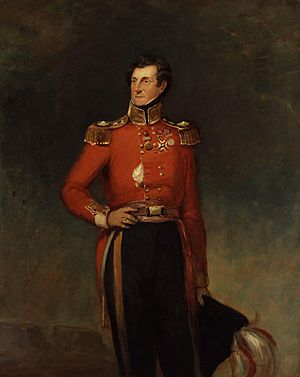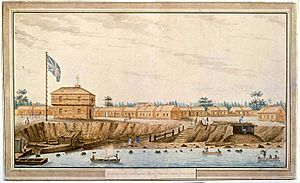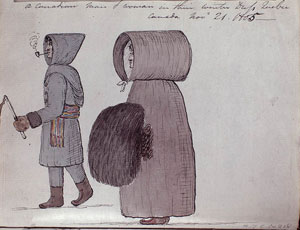Sempronius Stretton facts for kids
Quick facts for kids
Sempronius Stretton
|
|
|---|---|

Sempronius Stretton's portrait by William Salter (a study for his painting of the Duke of Wellington's banquet)
|
|
| Born | 15 May 1781 |
| Died | 6 March 1842 |
| Nationality | British |
| Known for | Artist and Colonel |
| Parent(s) | William and Susanna Stretton |
Colonel Sempronius Stretton (1781–1842) was a brave British Army officer. He fought in many important battles, including the famous Battle of Waterloo. He was also a talented artist. His drawings show what early life in Canada was like.
Early Life and Family
Sempronius Stretton was born in Nottingham, England, on May 15, 1781. He was the oldest son of William Stretton, who was a builder and also studied history. Sempronius was baptized at St. Mary's Church, Nottingham. He had an unusual first name, just like his brothers and sisters.
Artist and Soldier
Sempronius Stretton joined the army when he was quite young. He started his military career in April 1800, joining the Nottinghamshire Militia. In November of that year, he became an ensign in the 6th Regiment of Foot.
In April 1801, he was promoted to a lieutenant in the 49th Regiment. Soon after, he sailed to Quebec, Canada. While in Canada, he used his artistic skills to draw the landscapes. He also made important drawings of the local wildlife and the clothes people wore.
One of Stretton's drawings from 1804, called "York Barracks, Lake Ontario, Upper Canada," is one of the earliest pictures of what later became the city of Toronto. Lieutenant Stretton worked under Colonel Isaac Brock, who chose him to be his special assistant, called an aide-de-camp.

Later, he was promoted again to lead a company in the 40th Regiment. He then returned to England. Stretton's father recognized his drawing talent. Many of Sempronius's sketches were included in his father's historical records.
Military Honors and Famous Battles
In 1812, Captain Stretton sailed to Lisbon, Portugal. There, he met his brother, who was also an officer. Both brothers joined the army led by Lord Wellington. Captain Stretton's first major battle was the Battle of Vittoria on June 21, 1813. This battle helped end the rule of Napoleon Bonaparte's brother. Stretton even brought back Joseph Bonaparte's hat top from the battle!
On July 28, 1813, Captain Stretton received special thanks from Lord Wellington himself. This was for the brave defense made by the 40th Regiment, led by Stretton. They defended a position on the heights near Pampeluna. Because of his bravery, he received the Army Gold Medal and was promoted to the rank of major. His story of defending Pampeluna was even included in the regiment's history.
He fought in many more battles, ending with the Battle of Toulouse on April 10, 1814. After the army left France, he went with them to New Orleans in 1814. He almost lost his life when his ship was wrecked in Bantry Bay on October 10, 1814. From Cork, Major Stretton sailed on another ship and arrived at the Mississippi River on January 9, 1815.
The troops then returned to Portsmouth, England. The 40th Regiment, along with others, went to Flanders (part of modern-day Belgium). They joined the army near Brussels just in time for the famous Battle of Waterloo. During this battle, Major Stretton had his horse killed. After the Allies arrived in Paris, Arthur Wellesley, 1st Duke of Wellington, recognized Major Stretton's service. He appointed him as the commander of the 15th district of Paris. Stretton also received a silver medal for his service at Waterloo.
On June 21, 1817, he was promoted to Lieutenant-Colonel for his special services.
Later, when his regiment was ordered to New South Wales, Australia, he decided to retire. He spent several years traveling around Europe. Colonel Stretton was given a special honor called a Companionship of the Order of the Bath. He was also a guest at the Duke of Wellington's yearly banquet. This banquet celebrated the anniversary of the Battle of Waterloo. Stretton and other guests were painted in William Salter's 1836 painting, The Waterloo Banquet, which is at Apsley House. The National Portrait Gallery in London has a portrait of Stretton painted for Salter's famous work.
Later Life
Colonel Stretton died in Croydon, England, on February 6, 1842. He was buried in St Peter and St Paul, Bromley, in Kent. The house in Lenton, Nottingham, that he inherited from his father was left to his brother, Severus.



